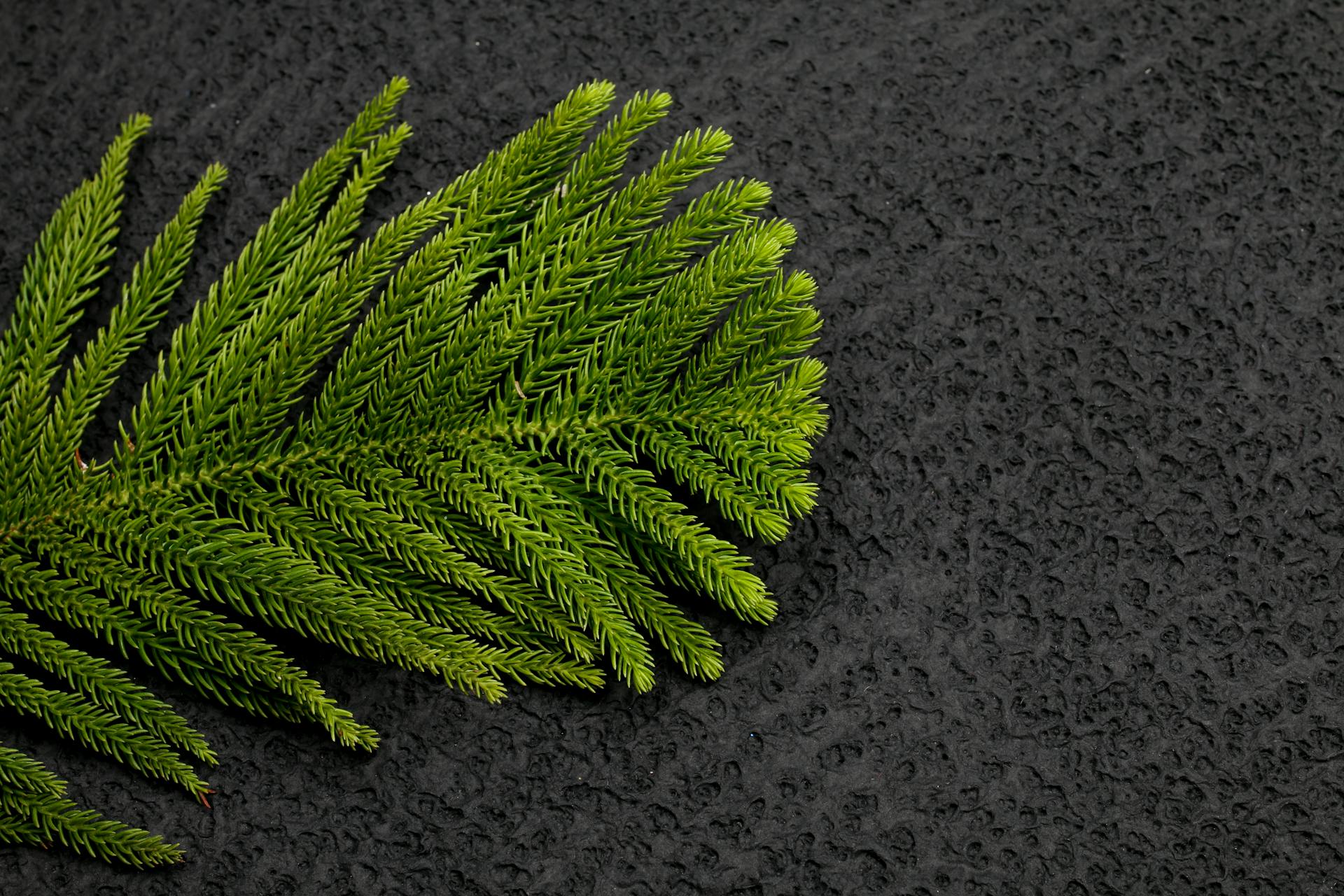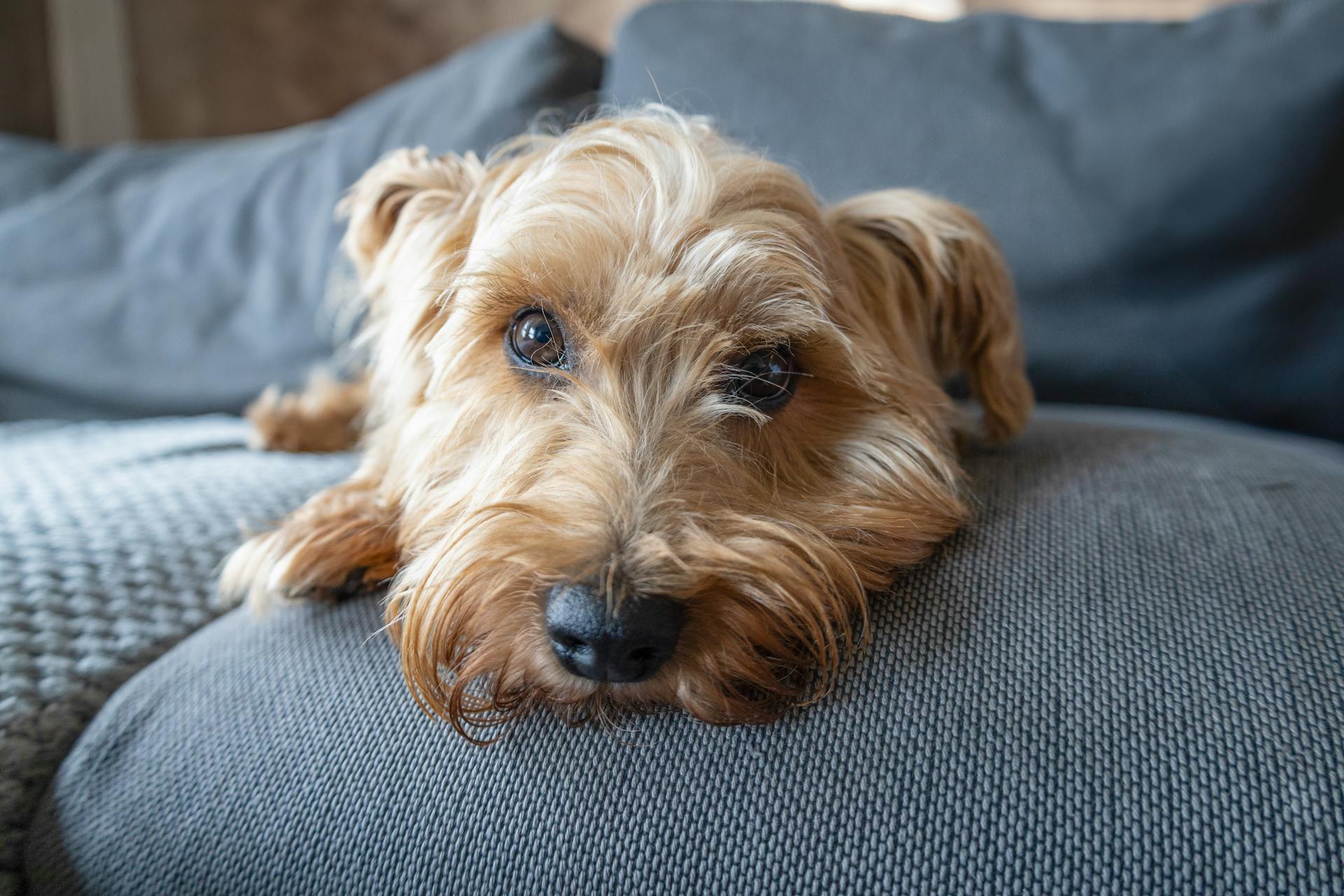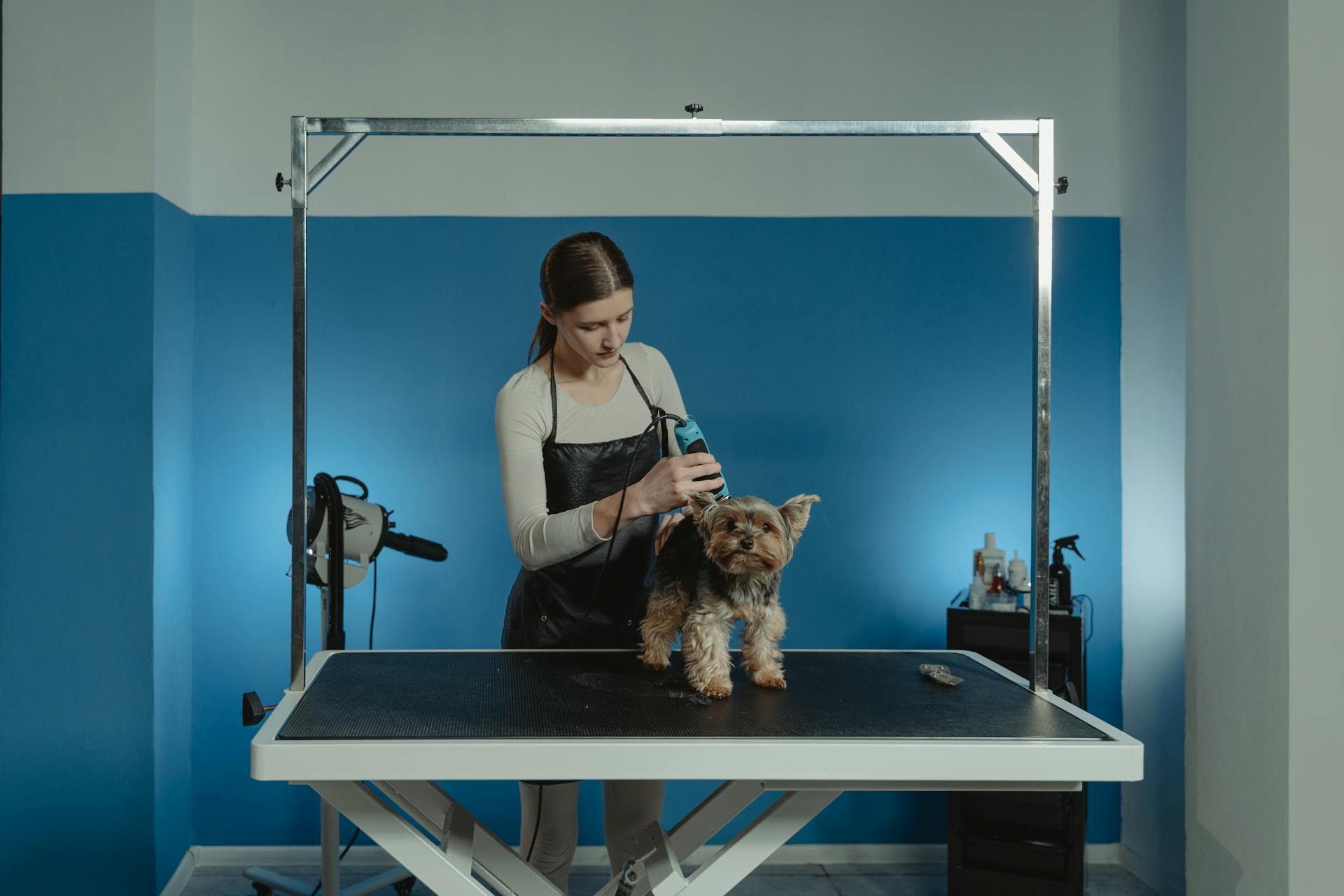
The Norfolk Terrier is a small, energetic dog breed that originated in England. They have a distinctive bearded face and a wiry coat that requires regular grooming.
These dogs are known for their friendly and outgoing personalities, making them great companions for families and individuals alike. They are also relatively low-maintenance pets.
The Norfolk Terrier typically weighs between 8-12 pounds and stands about 9-10 inches tall. They are a relatively small breed, but they pack a big personality.
Their energetic nature means they require regular exercise to stay happy and healthy, but they don't need a huge yard to run around in. A daily walk or playtime should suffice.
Care and Maintenance
The Norfolk Terrier is an easy-care dog, but he still needs regular exercise to stay happy and healthy. He requires at least one 20 to 30 minute vigorous walk or play session, or two 10 to 15 minute sessions every day.
Daily walks are plenty for this breed, but having access to a fenced-in yard is better, as he may be tempted to dig into it. He loves to dig, so be prepared to provide a safe outlet for this behavior.
The Norfolk Terrier has a double coat that sheds minimally, but he still needs regular grooming to prevent matting and tangling. Brush his coat once a week with a steel comb, and hand-strip him once in the spring and fall to remove loose, dead hair.
His nails need to be trimmed regularly, and his ears should be checked weekly for debris, redness, or swelling. Brushing his teeth daily can help prevent dental issues, and his teeth should be professionally cleaned by a vet at least once a year.
Overall, the Norfolk Terrier is a low-maintenance breed, but he still requires regular care and attention to stay happy and healthy.
Recommended read: English Bulldog Teeth
Size
As you'll want to ensure you're giving your Norfolk Terrier the right amount of space to move around, they're relatively small dogs, standing between 9 to 10 inches tall.
Their compact size also means they don't require a lot of room to exercise, but they still need regular physical activity to stay happy and healthy.
How to Care

To keep your Norfolk Terrier's coat looking its best, brush it at least once a week with a bristle brush to remove loose hair and dirt. Daily brushing is ideal, but a weekly combing will do.
Norfolk Terriers have a double coat that sheds minimally year-round, but they do shed in clumps twice a year, so be prepared for some extra grooming during those times. Hand stripping is necessary to get rid of loose, dead hair.
Bathing your Norfolk Terrier should be infrequent, ideally once every three months, as they can easily dry out their skin. If your pup gets dirty, a dog shampoo can be used, but make sure to clean them thoroughly.
To keep your Norfolk Terrier's teeth healthy, brush them daily with a soft toothbrush and doggie toothpaste. Regular toothbrushing is essential to prevent gum disease and tartar build-up on the teeth.
Norfolk Terriers need regular nail trimming, about once a month, to prevent overgrowth. If you can hear their nails tapping on the floor, it's time for a trim.
A daily walk of at least 20 to 30 minutes is necessary to keep your Norfolk Terrier happy and healthy. This can be broken down into two shorter sessions if needed.
Related reading: Healthy Bull Terrier
Health and Wellness
Norfolk Terriers are generally a hearty breed with a lifespan of 13.5 to 16 years, but they can be prone to certain health issues.
Mitral valve disease is a life-threatening heart condition that affects the breed, with up to 60% of Norfolk Terriers in America showing evidence of degeneration of the mitral valve. Responsible breeders are working to reduce or completely eradicate this condition in the breed.
Hip dysplasia is a common issue in many breeds, including the Norfolk Terrier, and can cause pain, lameness, and a decrease in activity and agility. X-ray screening for hip dysplasia is done by the Orthopedic Foundation for Animals or the University of Pennsylvania Hip Improvement Program.
Patellar luxation is a condition where the kneecap slides in and out of place, causing pain and discomfort for the dog. Treatment ranges from weight management and medication to surgery.
Arthritis can develop in Norfolk Terriers as they age, causing joint pain and stiffness. Regular exercise and a balanced diet can help manage this condition.
Curious to learn more? Check out: Bernese Mountain Dog Hip Dysplasia
Vaccination sensitivity is a reported issue in Norfolk Terriers, with symptoms including hives, facial swelling, soreness, and lethargy. Monitoring your dog closely after vaccination is crucial.
Here are some common health issues in Norfolk Terriers, along with their risk profiles and estimated costs of diagnosis and treatment:
To minimize the risk of health issues, it's essential to work with a reputable breeder who has tested their breeding dogs for genetic health problems. Ask for written documentation from the Orthopedic Foundation for Animals (OFA) or the Canine Eye Registration Foundation (CERF) clearing the parents of genetic health problems.
Broaden your view: English Bulldog Rash
Training and Behavior
Norfolk Terriers are exceptionally bright and easy to train, but they can be obstinate, especially during potty training.
Consistency is key when training a Norfolk Terrier, so be sure to take your pup out about 20 minutes after every meal and reward them when they potty outside.
Positive reinforcement works well for Norfolk Terrier puppies, so use treats, praise, and play breaks with fun toys to encourage good behavior.
For your interest: When Is the Best Time to Mate a Female Dog
Early socialization and obedience training are crucial to help your dog stay calm and quiet in new situations, and to redirect undesirable behavior like barking and digging.
The Norfolk Terrier's small size makes them a great choice for families with children, but adult supervision and training are still necessary.
These dogs are generally not diggers, but they do have a strong prey drive and may give chase to smaller animals.
Norfolk Terriers are relatively easy to house-train, but they do require regular exercise and playtime to stay happy and healthy.
Their rough coat sheds heavily, but weekly brushing or combing can minimize the problem, and occasional trips to a professional groomer can keep them looking their best.
Norfolk Terriers are naturally active and alert, and they thrive on action, so be prepared to provide plenty of exercise and playtime to keep them happy and engaged.
If you're not prepared for the terrier personality, you may find their independent streak and tendency to give chase frustrating, but with patience and training, you can learn to appreciate their lively and plucky attitude.
A unique perspective: How Long Does a Yorkshire Terrier Stay in Heat
Living with a Norfolk Terrier
They are a lively and energetic breed that requires regular exercise to stay happy and healthy.
Norfolk Terriers are relatively small dogs, weighing between 8-13 pounds and standing about 10 inches tall, making them a great fit for apartment living.
They have a short, easy-to-maintain coat that comes in a variety of colors, including red, wheaten, black, and tan.
Their intelligence and affectionate nature make them a great breed for families with children.
Norfolk Terriers are prone to certain health issues, such as patellar luxation and Legg-Calve-Perthes disease, so regular veterinary check-ups are a must.
They are generally quiet dogs and don't bark much, but they can be prone to howling, especially if they're bored or lonely.
Norfolk Terriers are highly social dogs and thrive on interaction with their family, so they need plenty of attention and playtime.
They are relatively low-maintenance when it comes to grooming, but they do require regular nail trimming and ear cleaning.
Their small size and adaptability make them a great breed for people who live in small spaces or have limited mobility.
Practical Considerations
When considering bringing a Norfolk Terrier into your family, it's essential to think about the practical aspects of dog ownership.
They need regular grooming, with a daily brushing to prevent matting and tangling of their double coat. This will also help reduce shedding.
Their exercise needs are moderate, requiring daily walks and playtime to keep them happy and healthy. A 30-minute walk in the morning and another in the evening should suffice.
You'll also need to consider their training needs, as Norfolk Terriers can be strong-willed and independent. Consistent, positive reinforcement training is recommended to help them learn good behavior.
With proper care and attention, Norfolk Terriers can live up to 12-15 years, making them a long-term companion.
Rescue Groups
If you're considering bringing a Norfolk Terrier into your life, you may want to explore rescue options.
Rescuing a Norfolk Terrier can be a rewarding experience, as they are loving and loyal companions.
The Norfolk Terrier Club is a great resource for finding a new furry friend.
California Norfolk Terrier Rescue is another organization that can help you find a rescued Norfolk Terrier in need of a loving home.
If you're interested in learning more about these rescue groups, you can start by visiting their websites or reaching out to them directly.
Pet Insurance
Pet insurance is a crucial consideration for Norfolk Terrier owners. Pet insurance for Norfolk Terriers costs more than for mixed breed dogs.
The cost is due to the breed's predisposition to hereditary conditions that are expensive to treat. These conditions can be devastating for owners who are not prepared.
Getting pet insurance for your Norfolk Terrier when he's a healthy puppy is the best time. This ensures you can't predict what will happen in the future, and pet insurance is the one thing you can't get when you need it the most.
Embrace dog insurance plans offer full coverage for all breed-specific conditions, excluding those that are pre-existing. This can provide peace of mind for owners who want to protect their pets.
Similar Breeds
If you're considering bringing a Norfolk Terrier into your family, you might be wondering if they have any similar breeds that share their characteristics. One of the breeds that shares a similar maintenance level is the Pugalier, which is 94% similar to the Norfolk Terrier.
Worth a look: Dogs Similar to Border Collies
If you're looking for breeds that are similar in size, the Norwich Terrier is a great option, weighing in at 98% similar to the Norfolk Terrier.
Here are some breeds that share similarities with the Norfolk Terrier:
- Pugalier (94% Similar)
- Norwich Terrier (98% Similar)
- Australian Terrier (94% Similar)
- Norjack (94% Similar)
- Pekingese (94% Similar)
Similarly Sized Breeds
If you're looking for breeds that are similar in size to the Norfolk Terrier, you've got a few options. The Norwich Terrier is a great match, with a similarity score of 98%.
The Norwich Terrier is a compact breed that weighs between 10-12 pounds and stands about 10 inches tall. They're known for their feisty and affectionate nature.
Another breed to consider is the Jatzu, which is 97% similar to the Norfolk Terrier. They're a relatively small breed that weighs between 8-12 pounds and stands about 10 inches tall.
The La Pom is also a good match, with a similarity score of 97%. They're a small breed that weighs between 7-12 pounds and stands about 9 inches tall.
Curious to learn more? Check out: Breeds Similar to Rhodesian Ridgeback
If you're looking for a breed that's a bit more exotic, the Maltichon might be the way to go. They're 97% similar to the Norfolk Terrier and weigh between 8-12 pounds.
Finally, the Tibetan Spaniel is another breed that's similar in size to the Norfolk Terrier. They weigh between 9-15 pounds and stand about 10 inches tall.
Here are some breeds that are similar in size to the Norfolk Terrier, along with their similarity scores:
- Norwich Terrier (98%)
- Jatzu (97%)
- La Pom (97%)
- Maltichon (97%)
- Tibetan Spaniel (97%)
Similar Maintenance Breeds
If you're looking for breeds that are similar to the Norfolk Terrier in terms of maintenance, you'll find that several breeds share similar characteristics.
The Pugalier is one of these breeds, with a 94% similarity in maintenance needs. This means that if you're willing to commit to regular grooming and exercise, a Pugalier can make a great companion.
Australian Terriers are another breed that require similar maintenance. They have a 94% similarity in maintenance needs, making them a great option for those who want a low-maintenance pet.
Discover more: Bernese Mountain Dog Look Alike
Norwich Terriers are also similar in maintenance needs, with a 94% similarity. They require regular grooming and exercise to stay happy and healthy.
Norjack and Pekingese are also breeds that share similar maintenance needs, both with a 94% similarity. If you're looking for a breed that is similar to the Norfolk Terrier, one of these breeds may be a great option.
Here's a list of breeds that are similar in maintenance needs to the Norfolk Terrier:
- Pugalier (94% Similar)
- Australian Terrier (94% Similar)
- Norwich Terrier (94% Similar)
- Norjack (94% Similar)
- Pekingese (94% Similar)
Frequently Asked Questions
What are the disadvantages of a Norfolk Terrier?
While generally a healthy breed, Norfolk Terriers can be prone to hip dysplasia, skin allergies, eye problems, and epilepsy. Regular veterinary care and monitoring can help manage these potential issues.
Do Norfolk Terriers like to cuddle?
Yes, Norfolk Terriers are known to love cuddling, making them a great companion for those who enjoy snuggling with their pets.
Do Norfolk Terriers bark a lot?
Yes, Norfolk Terriers can bark excessively if not properly trained, but with training, they can learn to control their barking. Proper training is essential to minimize excessive barking in Norfolk Terriers.
Is a Norfolk Terrier a good family dog?
Yes, Norfolk Terriers can make great family dogs, but it's essential to socialize and train them to interact safely with children. With proper care and attention, they can be a wonderful addition to a family.
Can Norfolk Terriers be left alone?
Norfolk Terriers are not suited for long periods of alone time and require regular interaction and exercise. They thrive with companionship and frequent walks or playtime.
Featured Images: pexels.com

